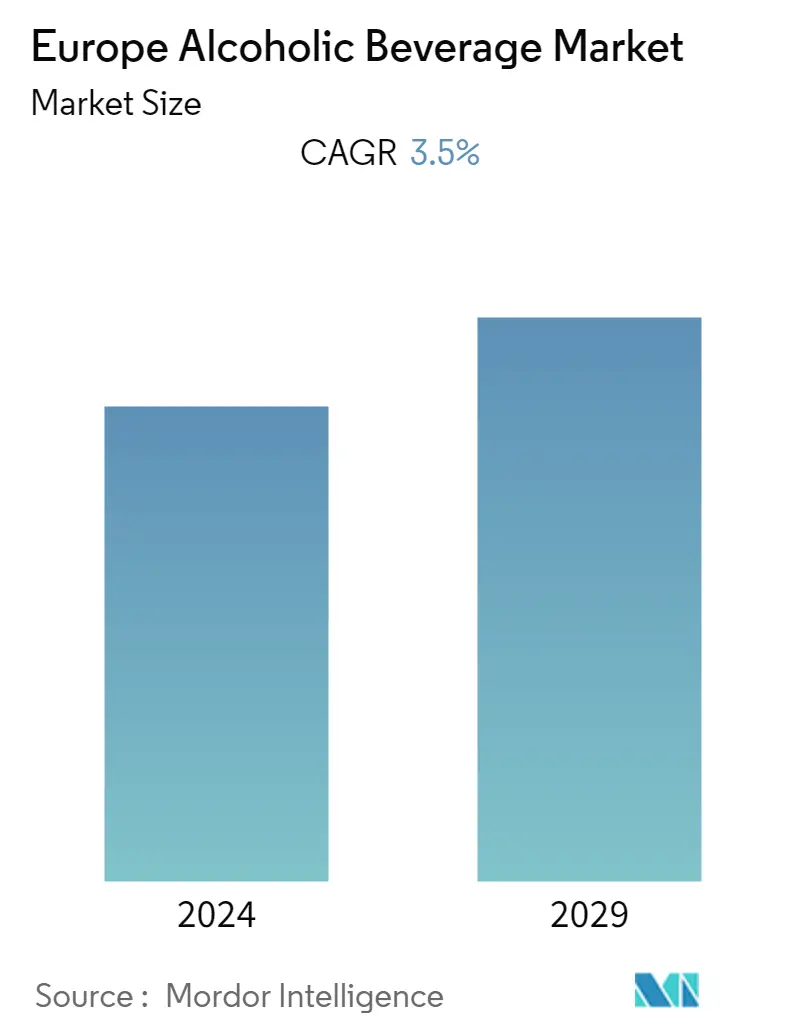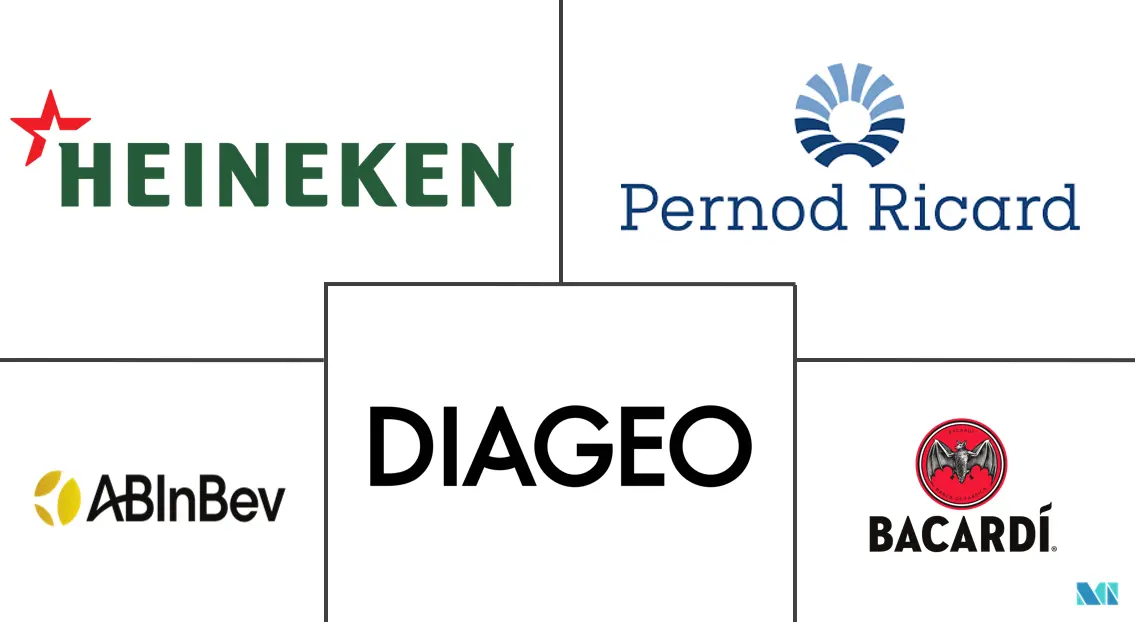Market Size of Europe Alcoholic Beverage Industry

| Study Period | 2019 - 2029 |
| Base Year For Estimation | 2023 |
| Forecast Data Period | 2024 - 2029 |
| Historical Data Period | 2019 - 2022 |
| CAGR | 3.50 % |
| Market Concentration | Low |
Major Players
*Disclaimer: Major Players sorted in no particular order |
Europe Alcoholic Beverage Market Analysis
The European alcoholic beverage market is projected to register a CAGR of 3.5% during the forecast period.
- Consumers across the region have been developing more sophisticated palates than before. They are constantly in search of unique as well as a high-quality alcoholic beverage. This has increased the demand for premium-quality alcoholic beverages in the market. Product innovation and economic growth make consumers opt for expensive alcoholic beverages. New product launches and innovations in alcoholic drinks are leading to the development of the industry.
- Companies are launching innovative products due to changing consumer preferences. This rise in health awareness has resulted in the creation of functional premium alcoholic beverages. The inclusion of different natural and exotic ingredients in alcohol tends to improve its functional properties, thereby gaining attention from a more extensive set of customers.
- For instance, in March 2022, Whitley Neill, a premium gin brand in the United Kingdom, launched a new gin variant, Oriental Spiced Gin. This gin consists of different botanicals and spices like coriander, ginger, chili, cumin, saffron, star anise, and grains of paradise.
- Furthermore, specialty beer has been gaining popularity among consumers in the Europe alcoholic beverage market, specifically younger consumers. The demand for light and fruity flavors in alcoholic beverages is driving the demand for craft beer, thereby escalating the demand for alcoholic beverages in the market.
- However, the prominence of health adversities associated with excessive alcoholic beverage consumption is prominent across Europe. The number of deaths related to alcohol consumption is rising, restraining the growth of the market studied.
- According to World Health Organization (WHO), as of 2022, the number of death caused by harmful use of alcohol catered to 3 million worldwide, representing around 5.3% of the total deaths across the globe. Therefore, the numerous health effects associated with alcohol might restrain the market's growth.
Europe Alcoholic Beverage Industry Segmentation
An alcoholic beverage is a drink containing ethanol, commonly known as alcohol. Alcoholic beverages are typically divided into three general classes: beers, wines, and spirits.
The European alcoholic beverage market is segmented by product type, distribution channel, and country. Based on product type, the market is segmented into beer, wine, and spirits. Based on the distribution channel, the market is segmented into on-trade and off-trade. The off-trade segment is further segmented into supermarkets/hypermarkets, specialist stores, online retail stores, and other off-trade channels. Based country, the market is segmented into the United Kingdom, Germany, France, Italy, Spain, Russia, and the Rest of Europe.
For each segment, the market sizing and forecasts have been done on the basis of value (in USD million).
| Product Type | |
| Beer | |
| Wine | |
| Spirits |
| Distribution Channel | ||||||
| On-trade | ||||||
|
| Country | |
| United Kingdom | |
| Germany | |
| Spain | |
| France | |
| Russia | |
| Italy | |
| Rest of Europe |
Europe Alcoholic Beverage Market Size Summary
The European alcoholic beverage market is experiencing a notable transformation, driven by evolving consumer preferences and a growing demand for premium and innovative products. As consumers develop more sophisticated tastes, there is an increasing inclination towards high-quality alcoholic beverages, including craft beers and specialty spirits. This trend is further fueled by product innovations and the incorporation of natural and exotic ingredients, which enhance the functional properties of these drinks. The market is witnessing a surge in the popularity of craft beer, particularly among younger consumers, who are drawn to light and fruity flavors. However, the market's growth is tempered by health concerns related to excessive alcohol consumption, which poses a significant challenge across the region.
The market landscape is characterized by a consolidation of major players, with companies like Diageo, Bacardi, Heineken, Pernod Ricard, and Anheuser-Busch InBev holding substantial market shares. These companies are actively engaging in product launches, mergers, acquisitions, and strategic partnerships to strengthen their market positions. The trend of premiumization is a key driver, particularly in the spirits and wine segments, with brands like Ciroc, Ketel One, and Smirnoff gaining prominence. The German market, in particular, is witnessing a rise in demand for refreshing alcoholic beverages and natural wines, supported by domestic tourism and the popularity of local wine varieties. Supermarkets and online retailing are becoming preferred channels for consumers, offering a wider range of premium and craft alcoholic drinks, thereby enhancing the quality perception among consumers.
Europe Alcoholic Beverage Market Size - Table of Contents
-
1. MARKET DYNAMICS
-
1.1 Market Drivers
-
1.2 Market Restraints
-
1.3 Porter's Five Forces Analysis
-
1.3.1 Threat of New Entrants
-
1.3.2 Bargaining Power of Buyers/Consumers
-
1.3.3 Bargaining Power of Suppliers
-
1.3.4 Threat of Substitute Products
-
1.3.5 Intensity of Competitive Rivalry
-
-
-
2. MARKET SEGMENTATION
-
2.1 Product Type
-
2.1.1 Beer
-
2.1.2 Wine
-
2.1.3 Spirits
-
-
2.2 Distribution Channel
-
2.2.1 On-trade
-
2.2.2 Off-trade
-
2.2.2.1 Supermarkets/Hypermarkets
-
2.2.2.2 Specialist Stores
-
2.2.2.3 Online Retail Stores
-
2.2.2.4 Other Off-trade Channels
-
-
-
2.3 Country
-
2.3.1 United Kingdom
-
2.3.2 Germany
-
2.3.3 Spain
-
2.3.4 France
-
2.3.5 Russia
-
2.3.6 Italy
-
2.3.7 Rest of Europe
-
-
Europe Alcoholic Beverage Market Size FAQs
What is the current Europe Alcoholic Beverage Market size?
The Europe Alcoholic Beverage Market is projected to register a CAGR of 3.5% during the forecast period (2024-2029)
Who are the key players in Europe Alcoholic Beverage Market?
Pernod Ricard, Diageo Plc, Bacardi Limited, Anheuser-Busch InBev and Heineken Holding NV are the major companies operating in the Europe Alcoholic Beverage Market.

